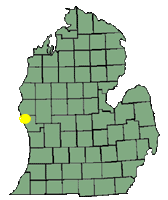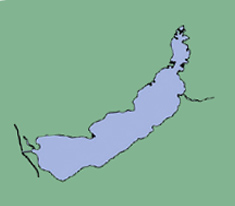Homes Vintage Images - Page1
HOMES VINTAGE IMAGES
PAGE 2
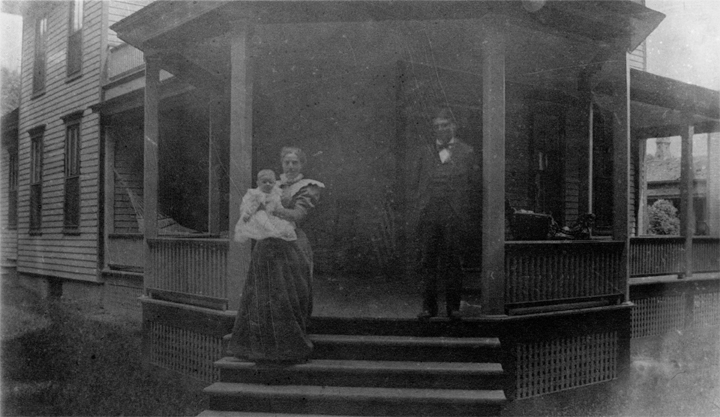
The picture of the house is undated. The people standing on
the porch are unidentified. It is believed that the house was
located on Division.
Lyman Townsend Covell was one of twelve children born in 1835
to Calvin & Elizabeth (Coleman) Covell of Ridgebury,
Pennsylvania. In September, 1859, he left Pennsylvania and
traveled to the White Lake area where he joined his brother
Andrew J., who had come three years earlier. Together they
went into the lumber business.
In 1862, a
brother-in-law, Joseph Hinchman, came to Whitehall and joined
the Covell brothers to form Hinchman & Covell in 1865. Due to
illness, Hinchman sold out his interest to H.E. Staples and
the firm changed its name to Staples & Covell. The firm
operated a boarding house in town for their men and had a
number of camps up the river. L.T. tried his hand at all
phases of the lumbering business. He was a camp cook, an axe
man, drove an ox team, rode logs, and managed the mill. In
1897, Covell purchased the Staples interest in the mill and
ran the business by himself until 1911 when it permanently
shut down.
He married
Eunice Hobler in 1866. They had 2 sons: George E. (1867-1954),
who became president of the State Bank of Whitehall; and Frank
H. (1869-1928), who was the manager of the L. T. Covell firm.
Lyman died in 1916. His wife Eunice died in 1926. They are
buried in Oakhurst Cemetery. |
Lyman T Covell
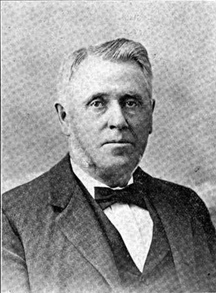
|
|
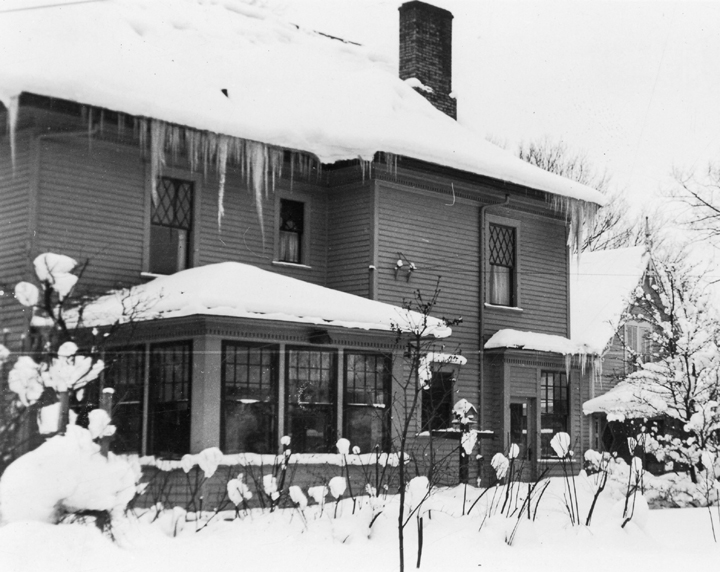
).
|
George Covell |
|
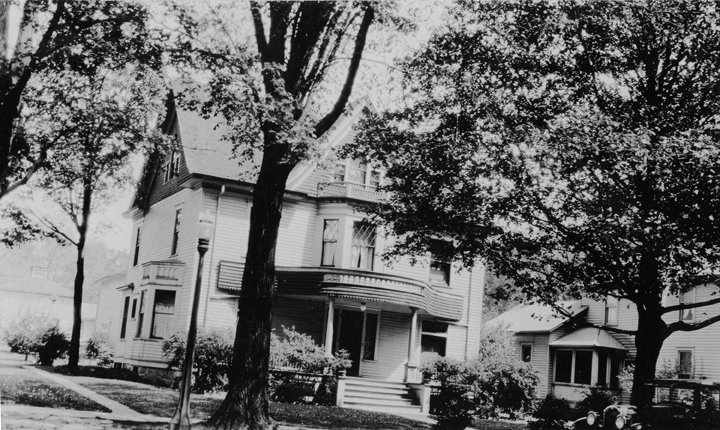
|
|
George Ellery Covell was born in
Whitehall in October 1867 to Lyman T. and Eunice (Hobler)
Covell. He graduated from Whitehall HS in 1885 and attended a
Grand Rapids college for a year. Upon his return to town, he
joined his father and brother Frank in the lumber business. He
married Clara McCulloch in Grand Rapids in November 1895. They
had a daughter Helen. In 1906, George left the lumber business
and became a cashier in the local bank. He remained in
banking, succeeding his uncle Mark B. Covell as president of
the State Bank, a position he held until his death in 1954.
Mrs. Covell died in 1953.
The George Covell house which was
located on Mears was razed around 1965 to make room for what
was then Muskegon Bank and Trust. The bank name has changed
several times since then and is now PNC Bank (in 2020)
|
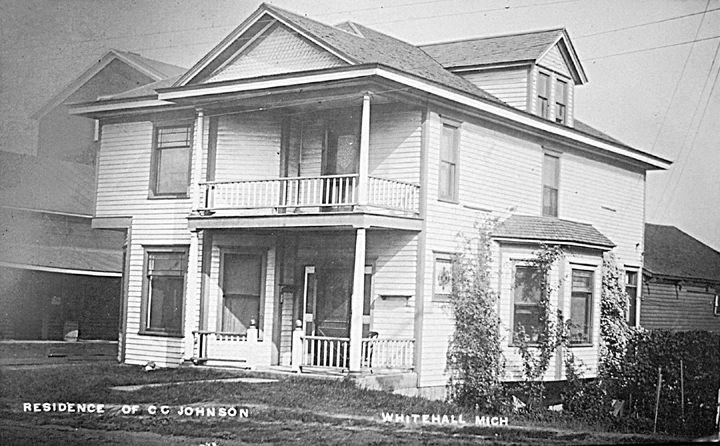
|
C C Johnson |
|
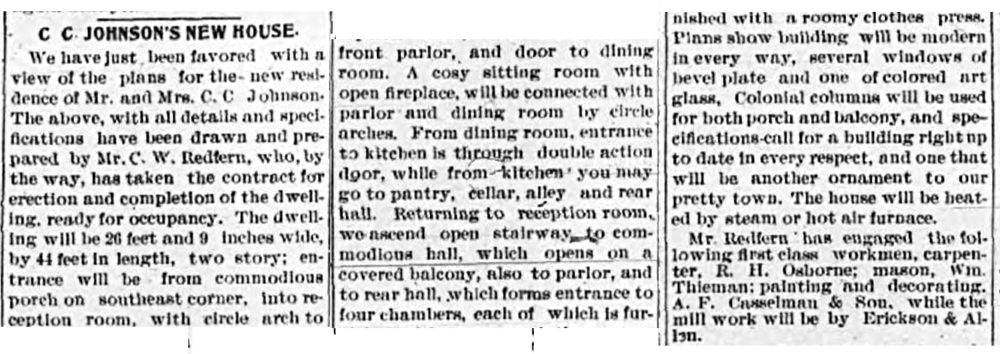 |
|
C.C. Johnson
Charles C. Johnson was born in Sweden in 1844. He came to
Whitehall in 1867. He tried his hand at saw milling but it did
not agree with his health, so he bought some land in the
Fruitland area and went to work for himself. He married Flora
Belle Stockwell in Whitehall in 1878; they had three children:
a son and two daughters.
By 1910 he
had moved back to Whitehall and became the owner and manager
of Whitehall Milling Company, which eventually moved to
Muskegon and became Johnson Milling Company.
Charles
died in May 1920. His wife Flora died in October 1923. They
are both buried in Oakhurst Cemetery.
The
following newspaper item from August 4, 1904, gives details of
the Johnson’s new house which was built in the Bunkerhill area
(according to an item about the foundation being laid which
appeared on the same date.)
|
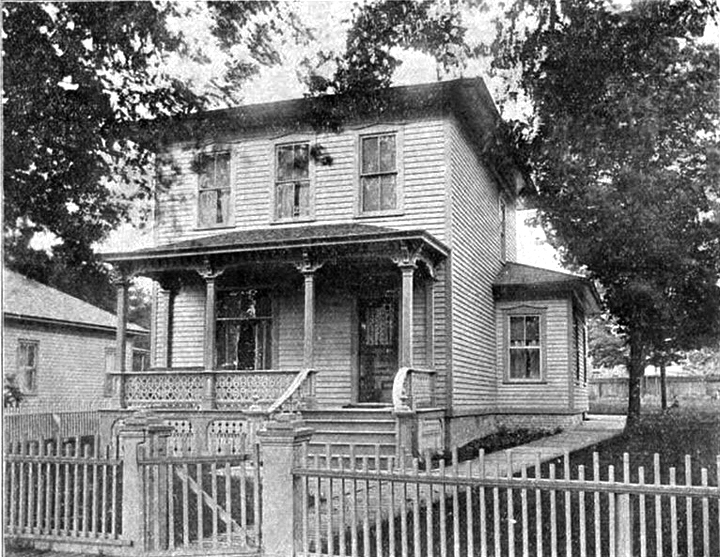 |
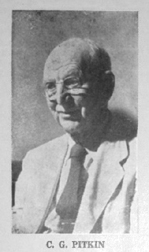 |
|
Clarence Grant (C.G.) Pitkin was
born in Ypsilanti in 1867, attended school there, and
apprenticed in his brother’s pharmacy store. He managed a drug
store in Stockbridge and Charlotte before coming to Whitehall
in 1887 at the peak of the lumber era. Here he managed a drug
store owned by the Covells, which was located in the area
where the former Masonic Temple building now stands. This drug
store was destroyed in the fire of 1890. Clarence then
purchased the stock and fixtures that remained and opened a
drug store where Pitkin’s Posh shop is now. In 1894, he
purchased the Conley Drug Store which was located at the site
of the present Pitkin’s Drug Store. On September 30, 1891,
Clarence G. and Anna Marie Knudsen were united in marriage at
the home of her grandparents, Mr. and Mrs. Henry Staples.
Following the wedding, they moved into their first home on
Division. At some point, they moved into this house on Mears.
They had two children: a son Clarence E. and a daughter Evalyn.
In 1917, C. G. sold the pharmacy business to his son Clarence
E. Pitkin. Mrs. Pitkin died in 1953 and C. G. died in 1957 at
the age of 89 years.
|
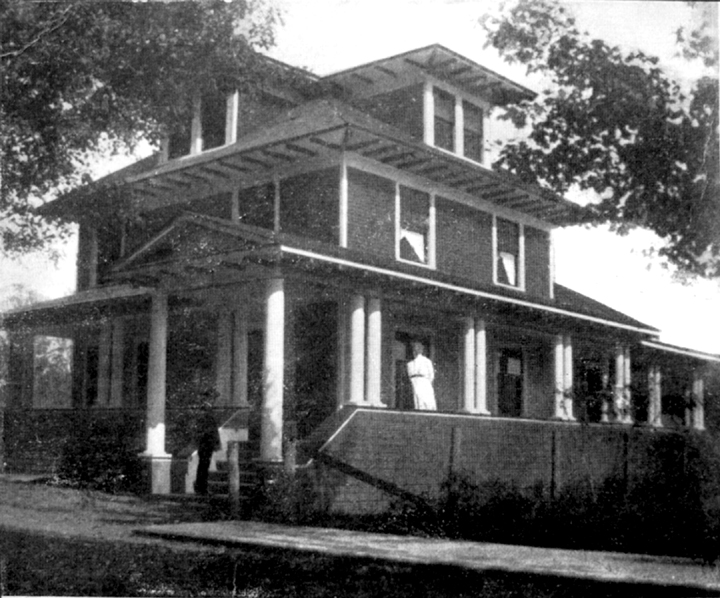 |
|
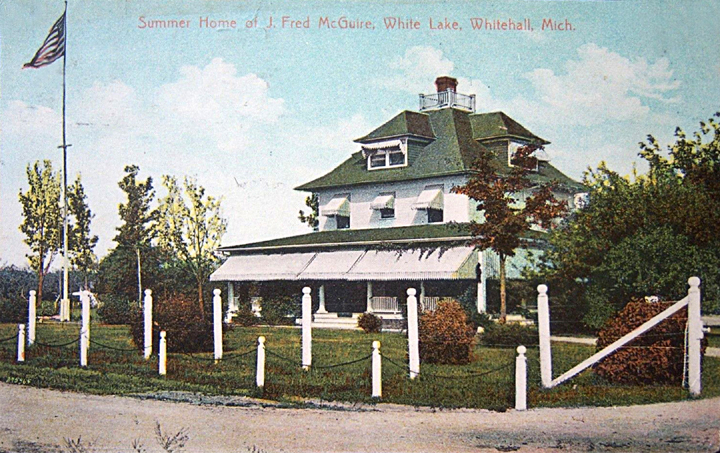 |
Fred McGuire
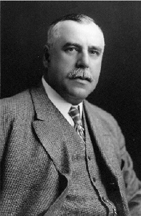 |
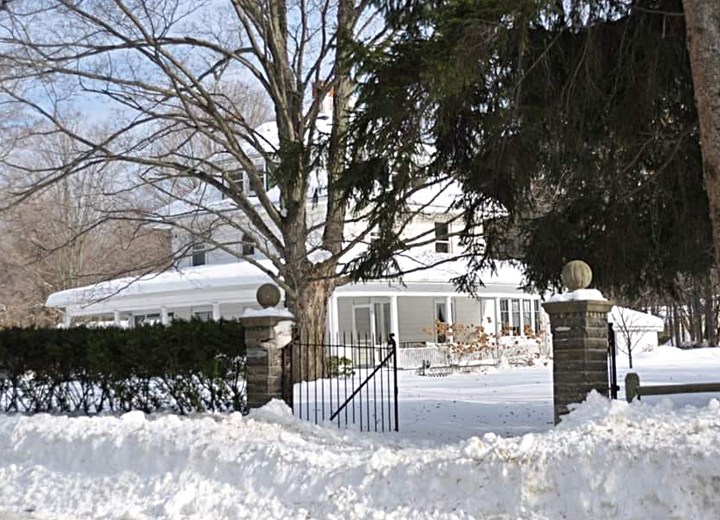
The J. F. McGuire name has appeared
in the local area newspapers since around 1903. John Frederick
McGuire was born in Chicago in 1868. He began his business
career as an office boy working for Wilson Brothers, a men’s
furnishings shop in Chicago before entering the real estate
and loan business in 1889. He went into business for himself
in 1897 forming the firm of McGuire, Orr and Wilson. Wilson
retired after 6 months and the name was changed to McGuire &
Orr.Fred married Sarah Reed in Riverside, IL, in 1888; they
had two children. He was involved in the reorganization of the
White Lake Yacht Club in 1907.
In 1912, Walter J. McGuire, son of J. Fred, became
associated with the firm his father founded following the
death of Mr. Orr that year.
Fred’s wife Sarah died in 1929; Fred died in 1943.
|
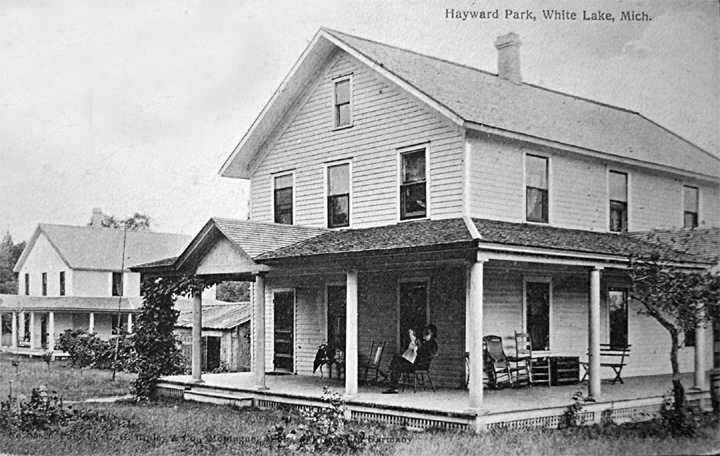
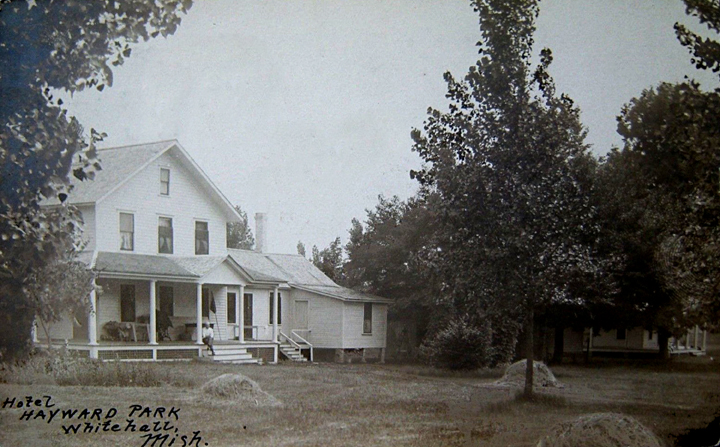
Before 1909
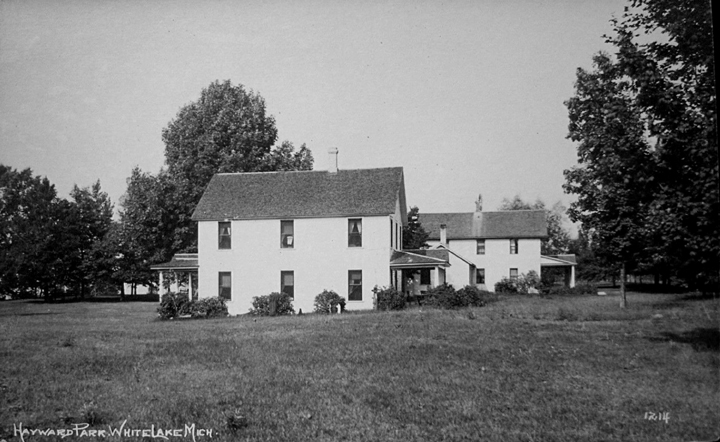
~1919
Hayward Park
was an early 1900’s summer Boarding House originally operated
by Ambrose D. Hayward, for whom it was named. He was born in
Maine in 1825; married Martha Wiley in 1851 in Massachusetts;
and together they had eight children. They were living in
Chicago in 1856, and as he was in the lumber business, he
maintained a close business relationship with Whitehall,
having extensive dealings with the Covell brothers and
interest in one of the mills. Ambrose bought land in the White
Lake area in 1860 and eventually created Hayward Farm.
Following his death in 1910, and that of his
wife in 1912, Ambrose’ oldest daughter Martha Jennie and her
husband William Garber continued to operate the White Lake
resort hotel known as Hayward Park. Prior to coming to the
area, Garber was in the grocery business in Lyons, Illinois.
He was born in NY in 1843; married Martha Jennie Hayward in
Chicago in 1888; and they had two sons and two daughters. Wm.
Garber died in 1932 and his wife Jennie Hayward Garber died in
1939.
|
Hayward Park
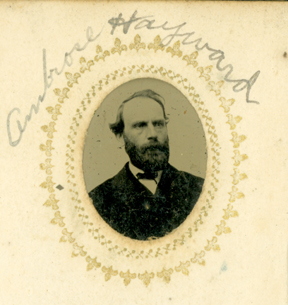
Ambrose Hayward |
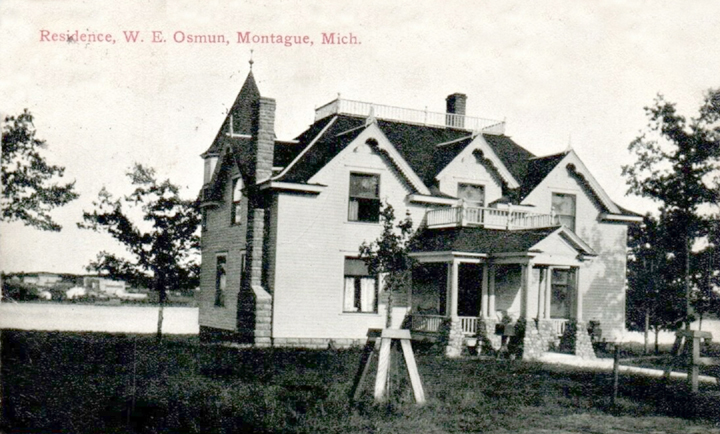
William E. Osmun was born November
18, 1850, in Ithaca, NY. He was schooled in the East and
studied law at Cornell University for two years before coming
to Michigan in 1880. He settled in Shelby and started a
newspaper known as the Enterprise, which he published for
three years. In 1886 he disposed the paper and came to
Montague, where he started another newspaper called the
Boomer, which was in competition with the Montague Lumberman.
He married Mary Windeknecht in August 1886; together they
raised his daughter Winnie. In 1889, Osmun gave up the Boomer
to concentrate on his law practice. In 1901, Osmun bought ten
acres of land boardering on White Lake and Coon Creek where he
built his house that became known as “Seven Gables”. He served
as President of the Village of Montague for seven terms and
was Postmaster from 1897-1904. He died in November 1929. His
wife died in March, 1951, in California at the home of her
step-daughter. |
W E Osmun
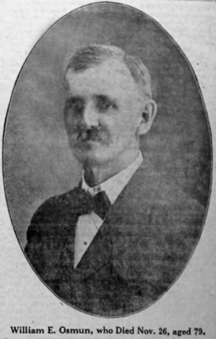 |
|
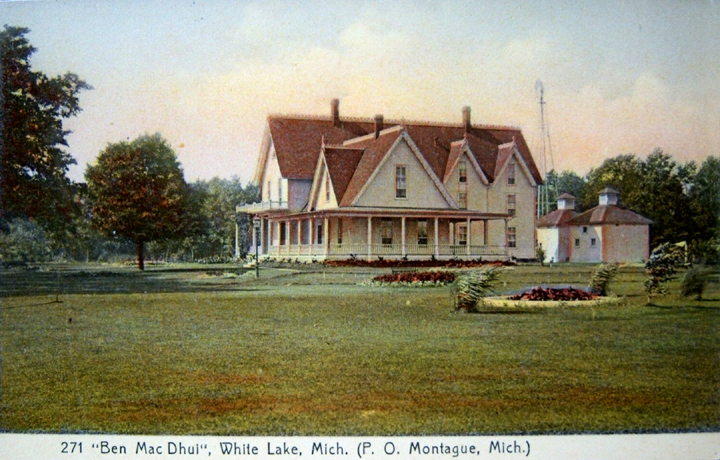
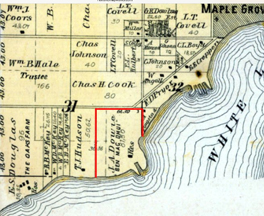
|
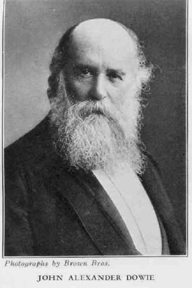
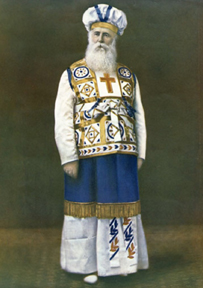
Ben Mac Dhui |
|
Ben Mac Dhui was the summer retreat
of Chicago faith healer John Alexander Dowie and his family.
He purchased his White Lake estate in September 1897 from
James & Peter Dalton. Originally known as “Grey Gables” it was
better known as the “old Dalton place”, and was built in 1870.
Dowie paid $10,000 for the 80 acres with frontage on White
Lake, and made many improvements to both the house and
property over the years. In 1902, an electric power plant was
built to furnish power and later a pumping station was added
to supply the property with water. This was done some years
before Montague had electric lights and city water. In 1904,
Dowie added to his land holdings by purchasing the neighboring
property owned by T. J. Hudson as well as a resort property
owned by E. S. Douglas known as “The Oaks”.
Dowie was born in Edinburgh, Scotland in 1847. He moved to
South Australia with in parents in 1860 but returned to
Scotland in 1868 to study theology. Returning to Australia in
1876, he married his cousin Jane Dowie and they had three
children: A. J. Gladstone (1877-1945), Jeanie (1879-1885), and
Esther (1881-1902). They moved to the U.S. in 1888 and
settling in Illinois where, in 1900, he bought 10 square miles
of lakefront land north of Chicago and founded Zion, Illinois.
In 1901, construction began on a 25 room mansion known as
“Shiloh House” in Zion City, which became the main residence
of the Dowie family. It is then that Dowie proclaimed himself
“Elijah the Restorer” and began to wear High-Priestly robes.
In 1905 Dowie suffered several strokes from which he never
fully recovered and died in March 1907at the age of 60 years.
It is then that the family learned that the estate was
bankrupt. His wife Jane and son Gladstone tried to maintain
Ben Mac Dhui for a time and operated it as a summer resort. In
1912, foreclosure proceedings were brought against the estate
for mortgage, principle and interest in the amount of
$9,823.89. In the Spring of 1914, Mrs. Dowie and Gladstone
left the area for Oklahoma and the house was put up for sale.
Jane returned to Illinois where she died in March 1933 and is
buried beside her husband. Their house in Illinois has been
restored and now serves as the headquarters of the Zion
Historical Society and the Zion Historical Museum.
Between 1915 and 1938, several people either leased or
owned the Ben Mac Dhui property, including Al Pack. There were
years when the house stood empty and vandals broke the windows
and doors and tore boards from the porches. The plumbing had
been removed and the fine old tiles in the master bathroom
were smashed. Finally in 1945, it was purchased by Mr. & Mrs.
Adolph Struven who owned the house until May 1948 when it was
completely destroyed by fire. The estate has since been
subdivided and the site of the Dowie house is now owned by Oxy
Chemical Company .
|
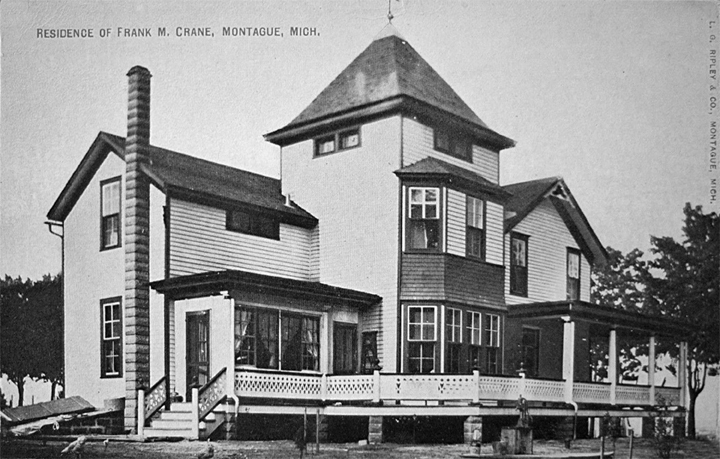
Frank M. Crane -
was a retired Division Manager for Montgomery Wards who came
to the Montague area in 1921. The house is also known as
"Valley View".
|
Frank M Crane |
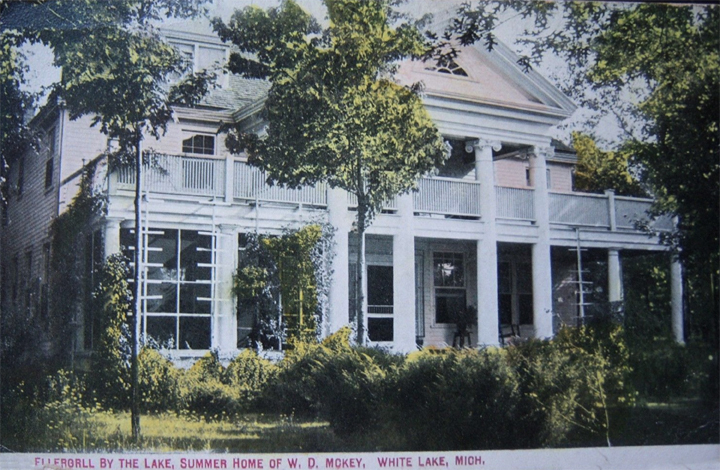
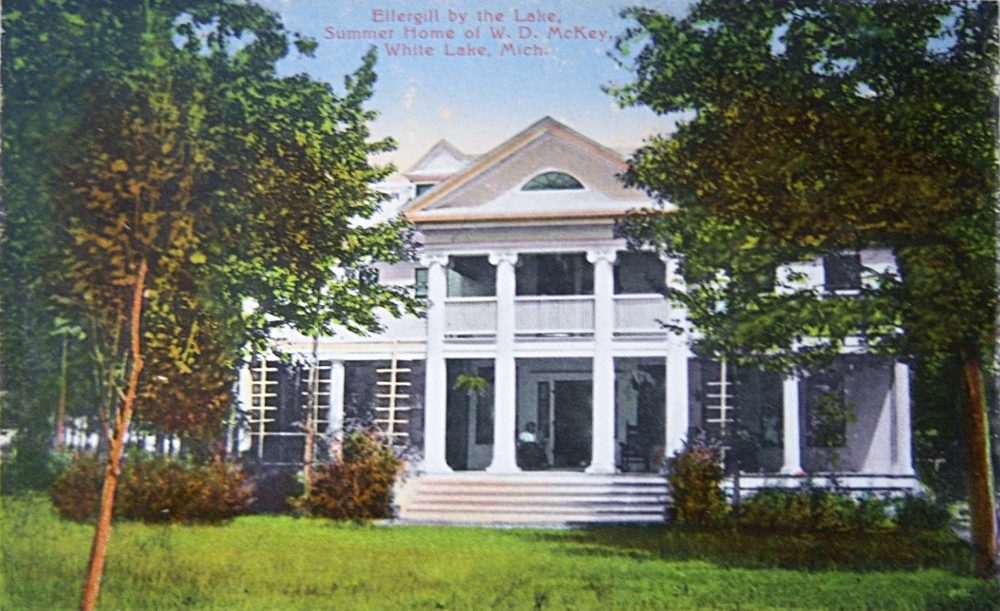
|
W D McKey
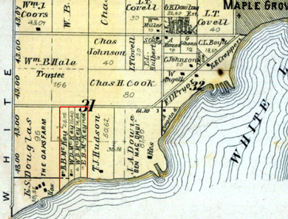 |
|
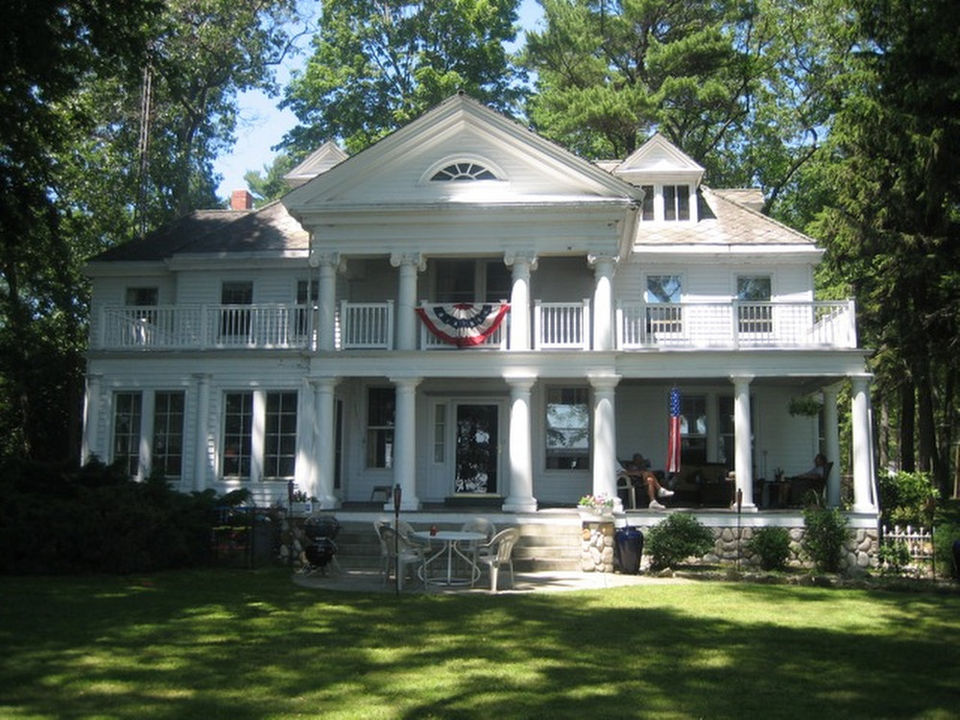 |
|
Ellergill
By The Lake, Summer Home of W. D. McKey
In
November, 1894, it was announced in the local newspaper that
Chicago resident W. D. McKey had purchased ten acres next to
the Douglas property on which he would be erecting an $8,000
cottage in the Spring of 1895.
William Davis
McKey was born in Janesville, WI in 1853. He, along with
Charles M. Poague, co-founded McKey & Poague, a real estate
service company in Chicago in 1889. McKey was also the
president of Woodlawn Trust & Savings bank as well a founder
of the Washington Park bank, both of Chicago.
William
married Grace Appleton; they had a son (who died as an infant)
and three daughters. He died November 11, 1915, at the age of
61 years. She died in July 1924.
A 1900 map of the local area shows property listed to W. D.
McKey and several other McKey families near the old Dowie
estate.
The McKey
home of Ellergill is now knows as the Timbers. It was
previously owned by the Sturtevants, Dunhams, Smiths and
Kurlands. It was operated at the Timbers Resort by the Smiths
and Kurlands from 1952-1983.
|
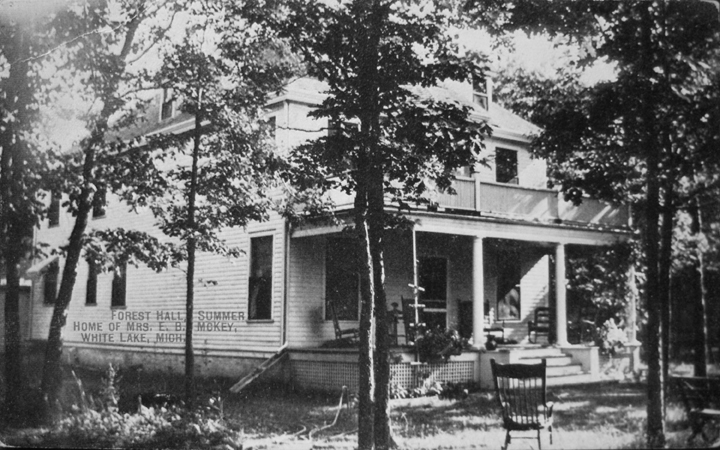
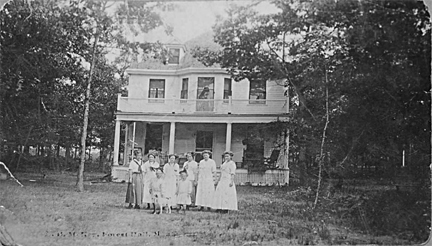 |
E B McKey
 |
|
Edward Boulger McKey was born in
Janesville, WI, in 1853. He went to Chicago in 1888 from
Janesville where he has been engaged in the dry goods business
with a cousin. In Chicago he was active in the real estate
business and well known as a receiver and trustee. E. B.
married Zoe Strong Gross in Chicago in 1878 and they had nine
children: five daughters and four sons. He died in Chicago in
August 1902 at the age of 49 years. His wife died in July
1924. The E. B. McKey name appeared on a local area map from
1900, along with other McKey family names, in an area near the
Dowie estate. In July 1915, an item appeared in the Montague
Observer indicating that Clyde Blain, of Chicago, had
purchased the E. B. McKey cottage on the lake shore.
|
|
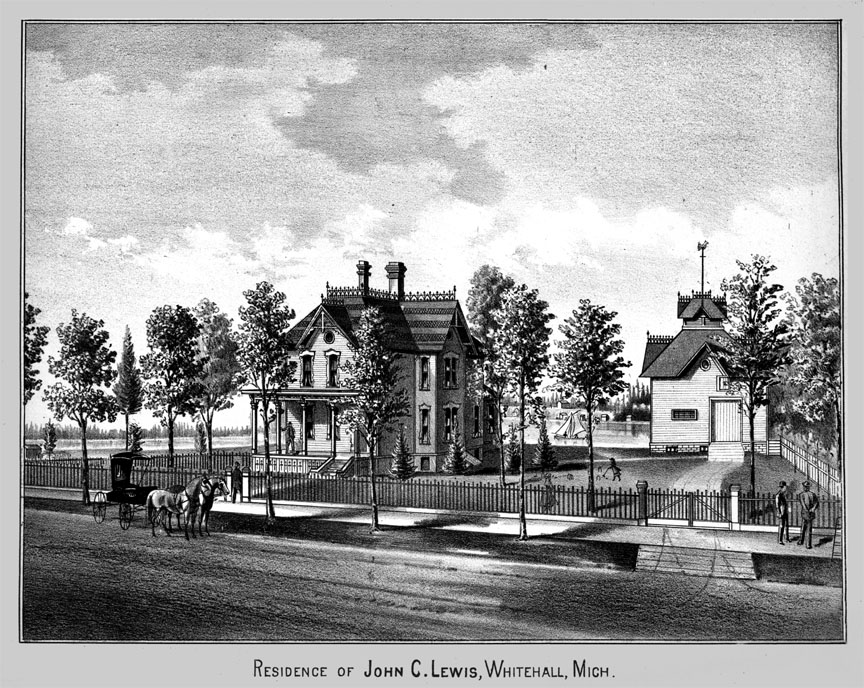 |
Lewis House |
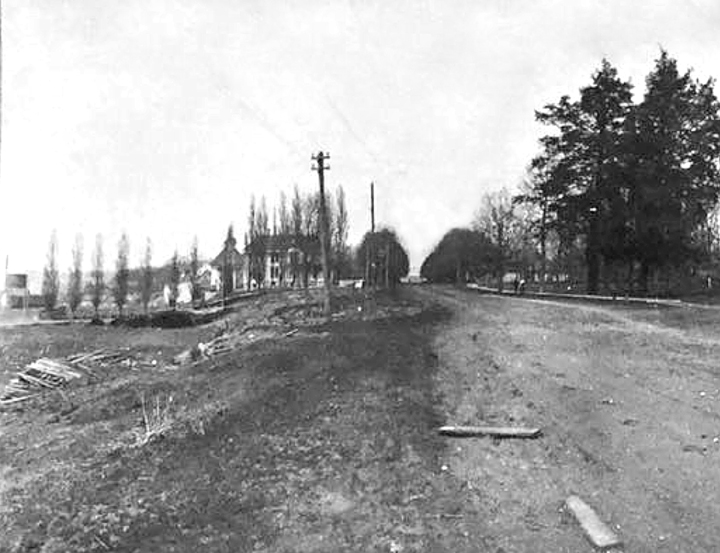
|
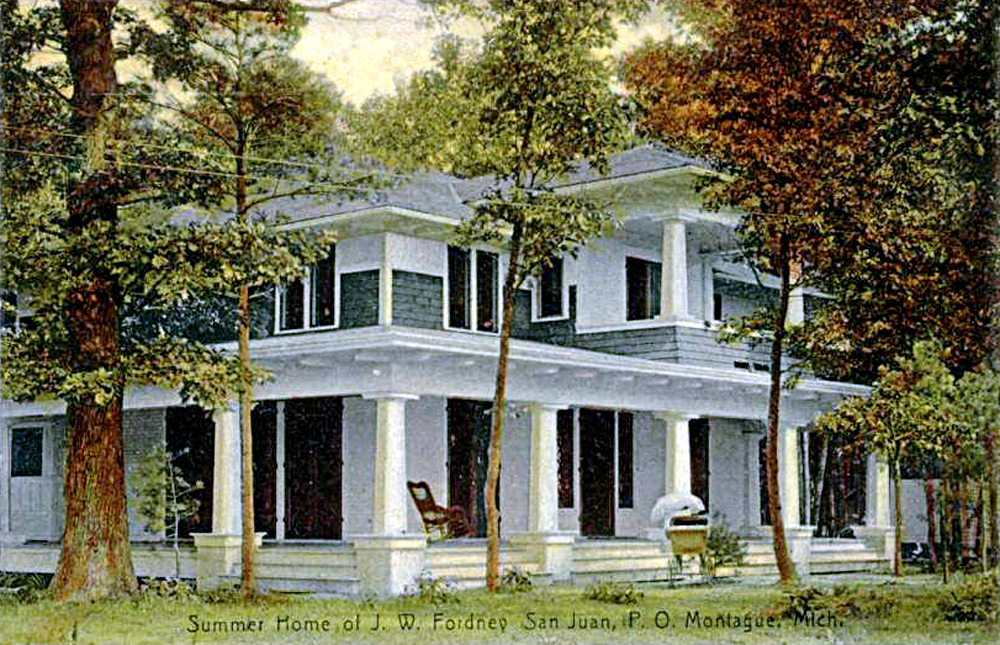
|
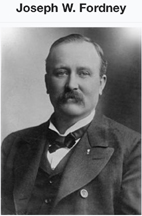 |
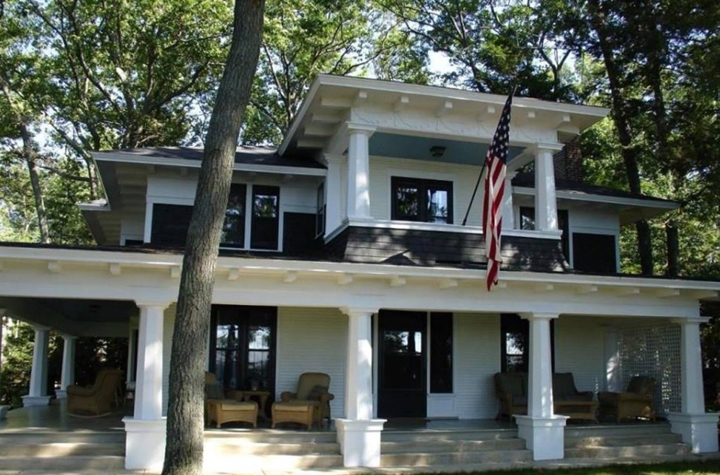 |
|
Summer Home of J. W. Fordney
Joseph Warren Fordney was born on a farm in Hartford City, IN,
in November 1853. He became interested in lumber business when
his family moved to Saginaw when he was around 16 years old.
He worked various job in the lumber business learning the
trade. He received the backing of a capitalist, eventually
adding lumber mills and yards to his holdings. He was also
credited with the development of the Michigan sugar beet
industry.
In 1873 he married Cathern Harren; they had nine children.
Fordney was one of Michigan’s leading citizens and was a
member of the U.S. House of Representatives for the Michigan
8th District for March 1899
– March 1923.
In 1907, then U.S. Congressman Joseph W. Fordney built his
5-bedroom summer home in the San Juan Association in Montague
at a reported cost of $8,000. In 2018, when the house was
listed for sale, the asking price was $799,000. The house
received the White Lake Historical Society Award in 2007.
Fordney died in Saginaw, MI, in January 1932 at the age of
78 years. His wife died there in 1934 at the age of 80 years.
His summer home was then sold in 1936 to Dr. & Mrs. H. M.
Grimson of Chicago, one of several owners in the home’s
history.
|
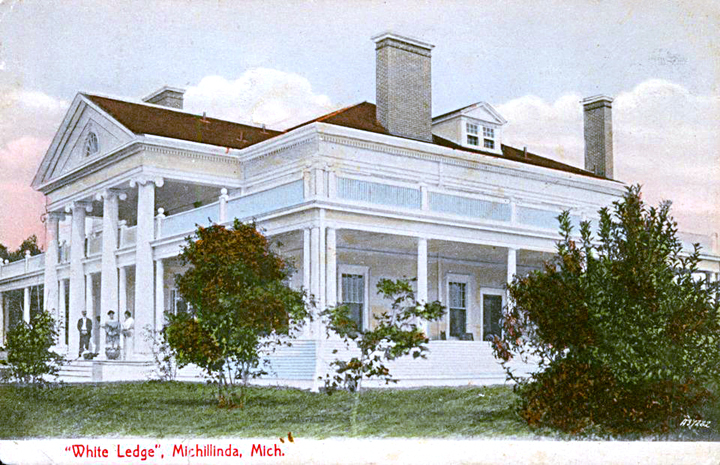 |
White Ledge
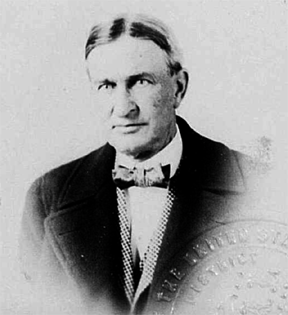
F G Allen |
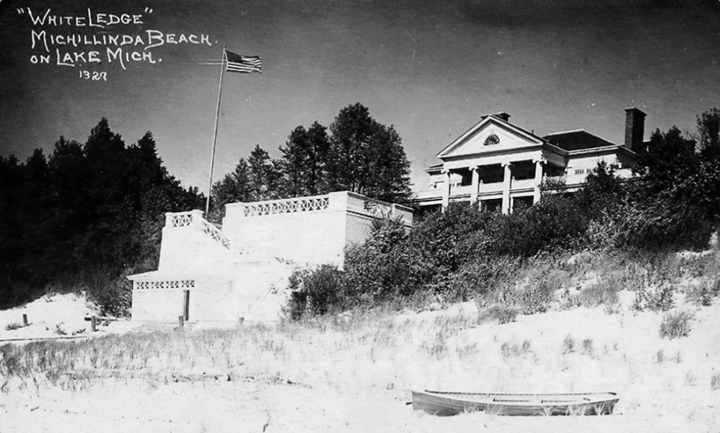 |
|
White
Ledge, the summer home of Frank Gates Allen of Moline,
Illinois, was built in 1904 on Scenic Drive near Michillinda
Beach, high on the bluff overlooked Lake Michigan. It was
reported that the home contained more than dozen rooms,
including a living room 22 X 45 feet, and was equipped with
all the modern conveniences of a city house. The interior of
the house was beautifully decorated and fully furnished . All
the building materials were brought here by boat and hauled up
the sand track which then existed along White Lake. An article
that appeared the Muskegon Chronicle on 21 Aug 1904, reported
the estimated the cost of the building and grounds was
$40,000.
F. G.
Allen was born in Aurora, Illinois, in 1858. He married Minnie
Stephens in 1882; they had a daughter Marjorie. He was
president and general manager of the Moline Plow Company,
president of the Moline State Trust & Savings Bank, and a
thirty-third degree Mason. Mrs. Allen died in 1933 and F. G.
Allen died in 1940.
|
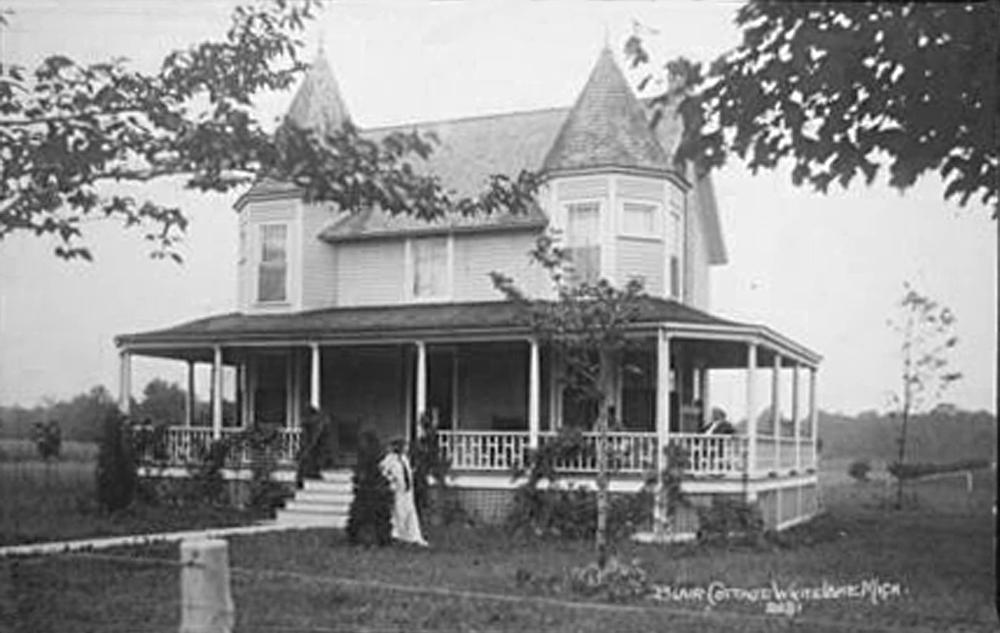 |
Blair Cottage |
|
